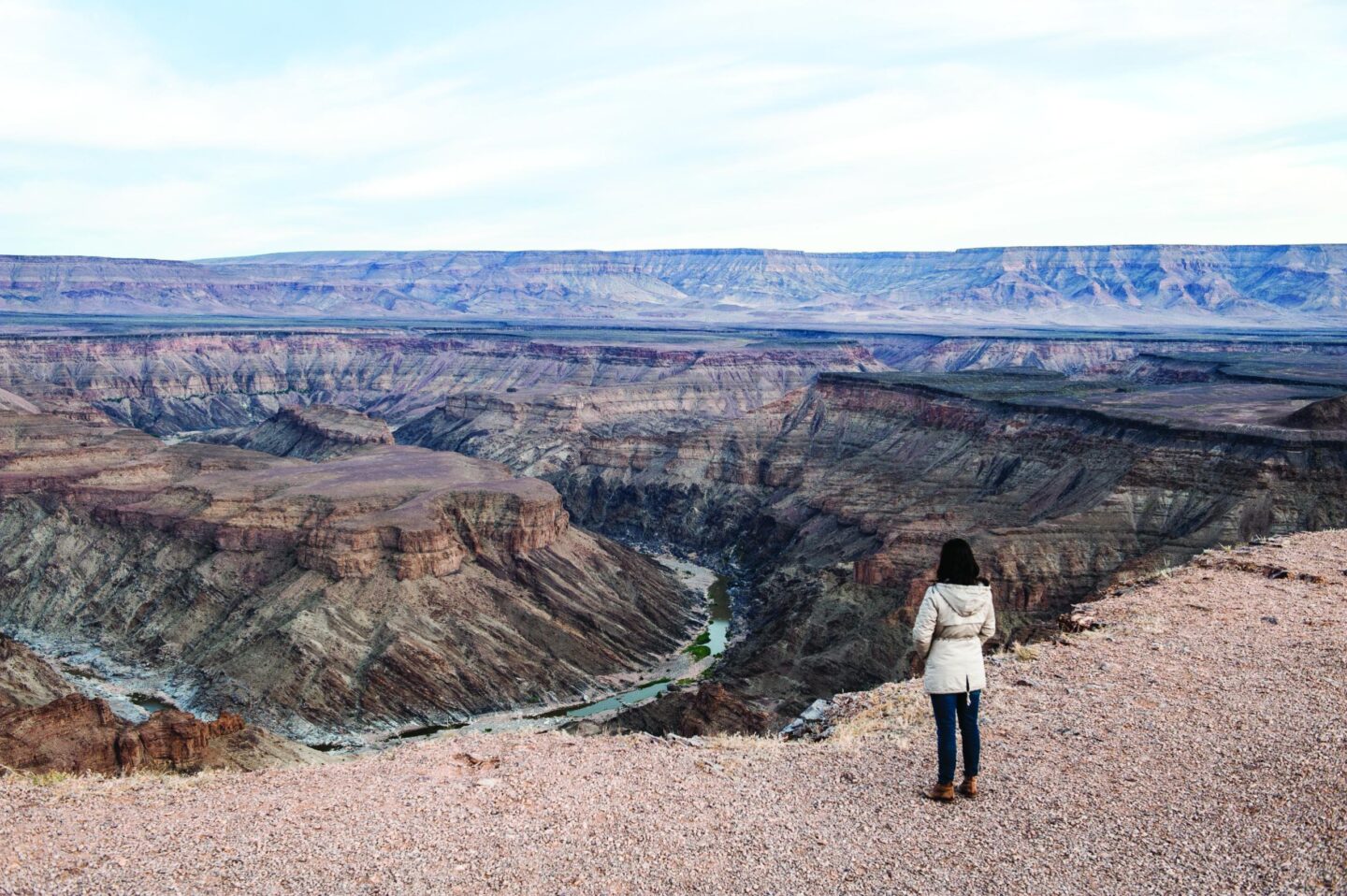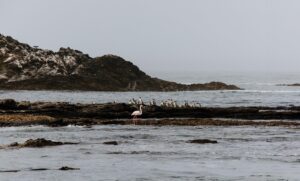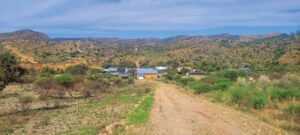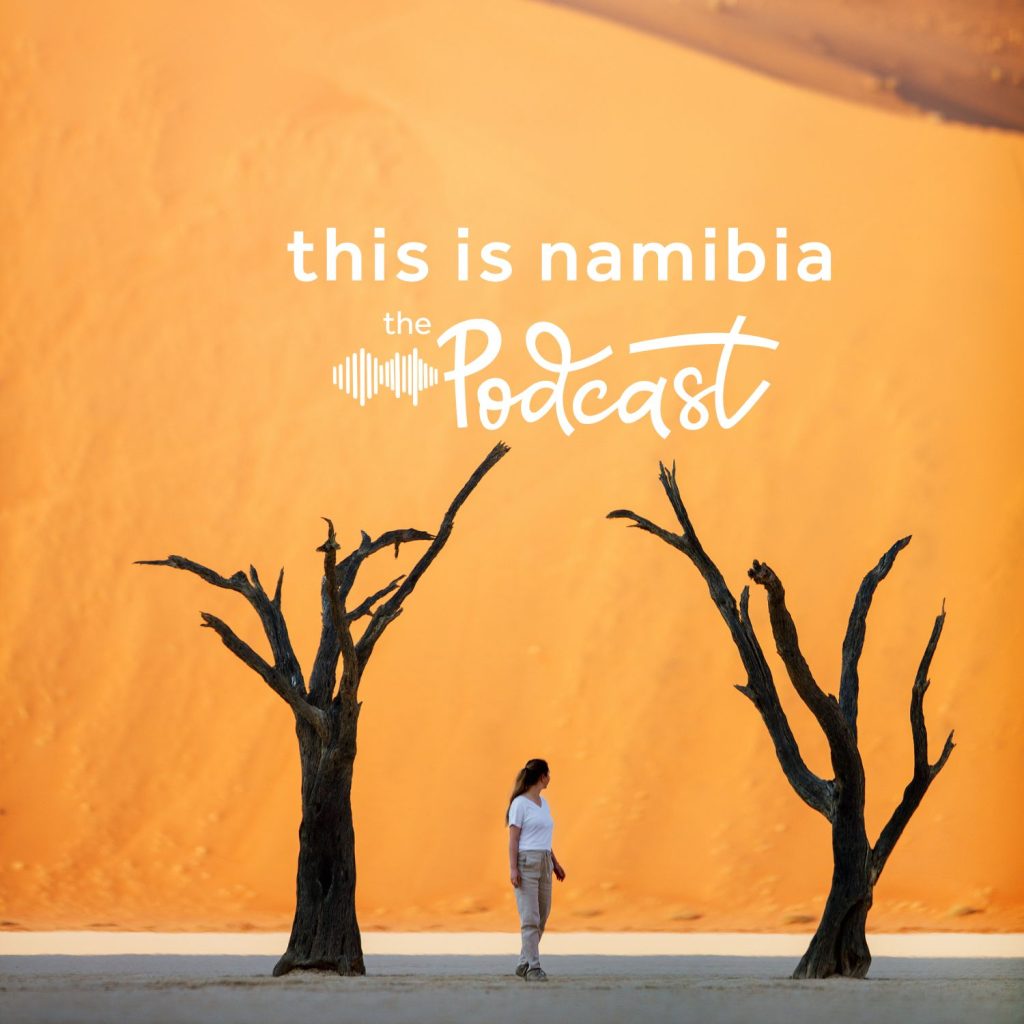

Discover
Southern Namibia
A region of unique landscapes, rich history and adventure
From the ITB 2025 issue
In the cool stillness of the early morning, I stood at the edge of the Fish River Canyon, the world awakening around me in shades of gold and amber. The crisp air carried the faint scent of morning mist, and as the first light stretched across the canyon’s rugged expanse, it was as if the earth itself exhaled, revealing its ancient secrets. Plum and lilac purple hues swathed the landscape before me. Below, the winding river shimmered like a silver thread, its course carved over millennia – a testament to time and the raw power of nature.
This is the beginning of many a journey through southern Namibia, a land that feels as untamed as it is inviting. Each destination here whispers a story, from the ghostly remnants of Kolmanskop’s diamond dreams to the salt- kissed air of Lüderitz, where history meets the sea. Out on the vast plains of the south, the silhouettes of far-off mountains emerge against a backdrop of endless blue sky.
Southern Namibia is a living, breathing canvas of contrasts, where adventure, history and beauty collide. A place that leaves its imprint on your soul, calling you back long after you have left its sunlit horizons. A land of striking contrasts where deserts meet the Atlantic Coast, ancient histories are etched in stone, and adventure beckons at every turn.
From rugged landscapes to eerie ghost towns, this region offers a unique blend of natural beauty, historical intrigue and endless opportunities for outdoor exploration. Whether you are captivated by rare flora found nowhere else on Earth or seek the solitude of isolated beaches, southern Namibia has something for every traveller.
Some key attractions
KOLMANSKOP: A GLIMPSE INTO NAMIBIA’S DIAMOND MINING PAST
Kolmanskop, Namibia’s most iconic ghost town, offers a captivating window into the past. Once a bustling diamond mining hub in the early 20th century, it now stands as a silent testament to a bygone era. Guided tours, either in person or via an app, lead visitors through the town’s once opulent world – a place where wealth and luxury once thrived. The eerie emptiness, enhanced by the desert sands slowly reclaiming the buildings, provides photographers with endless opportunities to capture striking, otherworldly shots. A visit to Kolmanskop is sure to linger in your memory long after you have left this hauntingly beautiful corner of Namibia.
LÜDERITZ: A COASTAL TOWN STEEPED IN HISTORY
Lüderitz, a charming coastal town, was once the epicentre of Namibia’s diamond rush in the early 1900s. Today, it offers a fascinating blend of history and modern-day revival. Nestled between the desert and the ocean, Lüderitz boasts well- preserved colonial architecture that tells the story of a place where wealth came and went in waves. Visitors can explore its heritage buildings, enjoy the tranquil atmosphere and take in the stunning coastal views.
For a deeper dive into the region’s history, make your way to Dias Point. In 1488, Portuguese explorer Bartolomeu Dias sailed into what we now know as Lüderitz Bay during his momentous voyage around the Cape of Good Hope. To mark his visit, Dias placed an engraved stone and a cross on a rocky outcrop that still stands today, defying the gale-force winds and crashing surf.
Make sure to stop in at Namibia’s first Maritime Museum, housed in the historic Lüderitz Old Power Station on Dias Street. This world-class museum spans five floors and brings the town’s deep maritime history to life, from tales of adventure and survival to the pressing challenges of modern marine conservation. It is a captivating journey through time, shedding light on the seafaring heritage that shaped Lüderitz’s past.
For a different perspective on Lüderitz’s stunning coastal landscape, why not embark on a catamaran cruise? Glide along the waters to see dramatic bays and islands, home to abundant wildlife, including the Heaviside’s dolphin and the African penguin. This serene boat ride offers an entirely fresh view of the untouched beauty of Lüderitz’s coastline and is the perfect way to take in the area’s natural splendour.
The hauntingly beautiful Deadvlei is a must-visit. Its cracked white clay pan, scattered with the skeletal remains of ancient camel thorn trees, creates a stark contrast against the vivid red dunes and cobalt sky. It is a surreal and otherworldly sight that leaves a lasting impression.
FISH RIVER CANYON: ONE OF AFRICA’S NATURAL WONDERS
The Fish River Canyon is a must-see for any traveller to southern Namibia. Its sheer size and the interplay of light and shadow on the rugged rocks create a breathtaking visual spectacle. Stretching over 160 km long, 27 km wide, and reaching depths of up to 550 metres, it is the second-largest canyon in the world.
Formed millions of years ago, the canyon offers stunning views and a variety of hiking opportunities. Whether you opt for a day hike or a multi-day trek, you are bound to explore deep gorges and striking rock formations.
TSAU //KHAEB NATIONAL PARK: A VAST AND UNTOUCHED WILDERNESS
Tsau //Khaeb National Park (formerly known as Sperrgebiet National Park) was proclaimed in 2008 and covers 26,000 km² of semi-desert terrain, making it one of the world’s top 35 biodiversity hotspots. Part of the Succulent Karoo biome, which stretches into South Africa, this area is rich in endemic succulent species – many of which are found nowhere else on the planet. Despite being largely undeveloped, sections of the park can be explored with registered concession holders.
The Sperrgebiet, or “forbidden territory”, has been off-limits to the public for nearly a century due to its diamond wealth, preserving its unique and pristine landscape. The park now protects 90% of the remaining Succulent Karoo habitat, home to over 2,400 endemic plant species.
Visitors can experience this untouched wilderness through guided tours, which include the ghost towns of Elizabeth Bay and Pomona, the Bogenfels Rock Arch, and Märchental, the “Fairy Tale Valley” where diamonds were once so abundant they could be picked up by the handful.
Other highlights include day and overnight trips to Dagger Rocks, Douglas Bay and the meteorite impact crater at Roter Kamm, as well as 4×4 dune driving, sandboarding and kayaking in the adventure zone of Oranjemund. Lüderitz serves as the starting point for guided 4×4 excursions into the Namib-Naukluft National Park, with options to visit Saddle Hill, Conception Bay and other historic sites.
SOSSUSVLEI AND THE NAMIB-NAUKLUFT PARK: A DESERT MASTERPIECE
No journey to southern Namibia is complete without experiencing the awe-inspiring beauty of Sossusvlei and the Namib-Naukluft Park. Renowned for its towering dunes and stark desert vistas, this region offers a glimpse into one of the planet’s most ancient and pristine landscapes. The dunes at Sossusvlei, some of which reach heights of over 300 metres, are among the tallest in the world. Climbing them at sunrise rewards visitors with breathtaking views as the golden light dances across the rippling sands.
The Namib-Naukluft Park, which encompasses Sossusvlei, is a haven for diverse wildlife adapted to the desert’s harsh conditions. From gemsbok and springbok to the elusive desert- adapted brown hyena, life here is a testament to resilience. Whether hiking the Sesriem Canyon, exploring the shimmering salt pans, or marvelling at the vastness of the Namib Desert, this region embodies the raw beauty and grandeur of the south.
THE NAMIB SAND SEA: A UNESCO WORLD HERITAGE SITE
Stretching across vast swathes of the Namib Desert, the Namib Sand Sea is a UNESCO World Heritage Site and a truly unique natural phenomenon. It is one of the only places on Earth where fog sustains a thriving desert ecosystem, supporting life in an otherwise arid environment.
This incredible expanse of ever-shifting dunes, sculpted over millions of years, is a geological masterpiece. The interplay of light and shadow on the dunes creates mesmerising patterns, captivating photographers and nature lovers alike. Visitors can explore the Namib Sand Sea through guided 4×4 excursions or scenic flights that reveal its vast scale and intricate beauty from above.
The Namib Sand Sea is not only a visual spectacle but also a reminder of the delicate balance of life in the desert, making it a must-see for anyone exploring the wonders of southern Namibia.

Some key attractions
HIKING AND TREKKING
Southern Namibia is a paradise for outdoor enthusiasts. The Fish River Canyon offers one of Africa’s top hiking trails, a challenging 85-km trek through deep ravines and rocky terrain. For a more moderate experience, there are several slackpacking options with Fish River Lodge.
WATER ACTIVITIES:
Despite the region’s arid nature, there are several options for water-based activities. Hardap Dam near Mariental is popular for freshwater fishing, with species like bass, carp and yellowfish. Lüderitz, known for its strong winds, is a global hotspot for kitesurfers and windsurfers. For a unique adventure, try a multi-day canoeing trip along the Orange River, where you can take in stunning desert views.
4X4 ADVENTURES AND SANDBOARDING:
The vast sand dunes of southern Namibia are an enticing challenge for adventure seekers. Guided concession tours into the Namib Sand Sea and along the Atlantic Coast offer an immersive and thrilling expedition for those looking to gain an intimate desert experience. Due to the ever-changing nature and sensitivity of the dunes and desert biomes, these stunning landscapes are best explored with an experienced guide who knows the terrain.
Rich cultural and historical heritage
HISTORICAL TOWNS
The southern region is dotted with towns that provide insights into Namibia’s colonial past. Keetmanshoop, for instance, is home to the Rhenish Mission Church and the Eagle Monument, which commemorate the town’s early history. In Aus, visitors can explore the Commonwealth Cemetery, which honours those who died during World War I and of the Spanish flu pandemic. Bethanie boasts some of the oldest buildings in the country, including the Schmelenhaus, built in 1814.
GHOST TOWNS
For those intrigued by history and the remnants of past industries, the ghost towns of southern Namibia offer fascinating exploration. In addition to Kolmanskop, there are other abandoned mining camps and towns such as Elizabeth Bay and Pomona, where the ruins tell the story of the diamond rush era and the once-thriving mining communities that vanished when resources ran dry.
SHIPWRECKS AND THE SPERRGEBIET COAST
The coastline of southern Namibia is famous for its shipwrecks. In 2008, a significant find of gold coins, ivory tusks and silver artefacts was uncovered from a Portuguese shipwreck off the coast. The Tsau //Khaeb National Park’s remote and untouched nature makes it an exciting place for those interested in maritime history and treasure hunting. The newly opened Maritime Museum in Lüderitz is rife with treasures and intrigue.
WHY VISIT SOUTHERN NAMIBIA?
Southern Namibia is a land where adventure and history converge, and natural wonders await at every turn. From the vastness of the Fish River Canyon to the ever-changing coastline and the unique desert wildlife, the region offers something for every traveller. Its untouched landscapes, rich cultural heritage and thrilling outdoor activities make southern Namibia one of the country’s most captivating and rewarding destinations.
More to explore


Discover Airlines launches a new direct flight between Windhoek and Munich




Discover Airlines launches a new direct flight between Windhoek and Munich





